Moss can be a major problem when it substantially grows and stays on your roof. It not only shortens your roof’s lifespan but also can severely compromise the integrity of the entire roofing system resulting in costly repairs. It’s thus only natural that you’d want to get rid of it.
To remove roof moss simply scrub and hose it off, use homemade killer recipes such as vinegar or use store-bought moss removers. The best time to remove is during summer. Regular cleaning and maintenance are the most effective ways to prevent moss growth.
The following is a detailed discussion of the various roos moss removal methods including natural, detergents, best removers, prevention measures, removal cost, and more. Also, find answers to frequently asked questions including why moss is bad on your roof shingles and tiles.
How to Remove Moss from Roof Naturally without Chemicals
There are several ways you can do away with moss on your roof naturally without having to use harsh cleaning chemicals and procedures that might not only damage your roofing but also harm animals or plants around your house and the entire environment.
Natural roof moss removal methods include; manually scrapping and scrubbing, blowing and sweeping, hosing and brushing, soft power/pressure washing, eliminating moisture and shade, changing the PH level, etc. Following are the details.
Some of the tools you need include;
- Safety Gear- Gloves, Goggles, Slip-resistant shoes, helmet, Harness, Lifeline
- Pressure Cleaner(for size job)
- Garden Hose/ Sprayers
- Roof Cleaning Brush/Scraper/Trowel
- Cleaning Solutions
- Ladder for high roofs
Scrapping and Scrubbing
One of the easiest and most cost-effective natural ways to get rid of roof moss without chemicals is to manually brush and scrape it away using handheld tools including a long-handled brush, plastic scrapers/knives or trowels. With this method, you can easily remove any gunk or debris, without damaging your roof shingles or tiles.
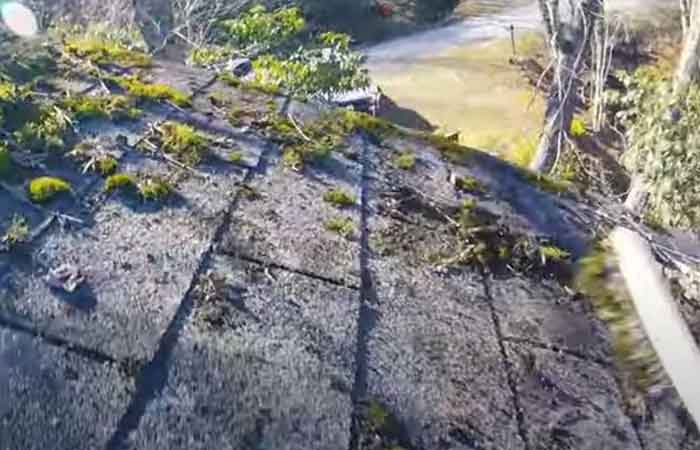
Remember to scrub the roof from top to bottom end with the edges close to the gutters. Start with the brush to remove loose and dried moss then use a scraper or trowel for the remaining tough and stuck moss. To avoid damage while removing moss from your roof, be gentle and use a plastic scraper or brush that is specifically designed for the type of roofing material you have.
Scrapping or gentle brushing however isn’t effective on its own because it may leave some moss in cracks and areas where the brush/scraper can’t reach. Therefore, it should be done in conjunction with a water hose/sprayer to rinse remnants off the roof because moss, in the presence of moisture organic matter, can quickly grow back into your roof and spread quite fast.
Brushing especially, during a dry and windy day, can also easily spread the moss spores to the surrounding environment which means the moss will likely grow back in a matter of days if the conditions are right.
Blowing & Sweeping
This is method works when the moss on your roof is loose and dehydrated particularly when the weather has been hot and dry. All you need is a blower or a broom to blow or sweep out the moss.
If you have a metal roof all this method on its own can do away with the moss. For non-metal roofs, you might require secondary preventive measures since this does not do away with all the moss.
Avoid air-blowing a composition roof, because it can lift self-sealing shingles and cause leaks.
Hosing and Brushing
Hose off the area with plain water, spraying at a downward angle. Then, use a long-handled soft-bristle scrub brush to remove the moss from the roof, scrubbing from the top down to avoid lifting shingles. As you continue, rub gently—don’t scrape, scour, or pound on the roof—and work in one small section at a time to avoid ripping, cracking, or breaking the shingles.
Changing PH
Lowering or increasing the PH level is a limiting factor restricting the moss habitat and killing moss. According to Margaret Dieter, a bryologist, some species of moss have optimum growth at PH 8.0 -8.5, but at the PH of 3.5 there is no growth.
Another study, by Armentano et al., published in The Bryologist Journal, observed the effect of pH levels of 3.5, 5.8, 6.4 and 7.8 on moss growth. There was a difference in the growth of moss confirming that the pH level limits moss growth and kills it.
Most mosses are thought to grow in an environment with a pH of 5.0, 5.5 or 6.0. which means that increasing the acidity (pH level of below 3.5) or alkalinity (pH level of more than 8.5) of the roof surroundings will make it difficult for moss to survive.
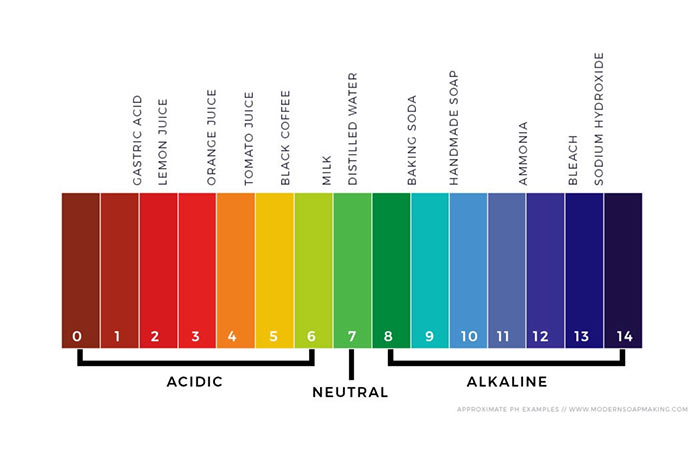
Common household items with a pH level of 3.5 include orange Juice, Lemon Juice, tomato juice, and Apple Cider Vinegar (White distilled vinegar). Spray these products directly on moss. These products can be corrosive on some roof surfaces but diluting the mixture can prevent corrosion.
Ammonia, liquid soap, bleach, and baking soda are all readily available alkaline products that can be used to raise the pH of the roof. These products can kill moss on your roof by combining them with water or applying them directly to it.
You can also use lime to change the pH of your roof’s surface. Although hydrated lime does not kill moss, it does make the surface more alkaline, which discourages moss growth.
Although changing the pH level has an effect on moss growth, it is important to keep in mind that mosses are highly adaptable plants that will grow in acid, neutral and even alkaline environments, hence this pH-changing method may fail.
Deprive the Moss of Moisture and Shade
This is ideal especially, for flat roof owners who live in areas with high precipitation and many trees.
While this method is more of a prevention measure, it rids moss indirectly by eliminating the conditions (moisture and shade) that favor the growth of moss on the roof.
Water retention is a common problem with flat roofs. While pitched roofs have a natural slope where the water can run down, draining off the roof, flat roofs lack the natural slope and hence do not drain water effectively.
The water might not pose an instant threat, however, over time it can encourage moss, algae, and other vegetation on your roof. Eventually, this shortens the lifespan of your roof and leads to other structural damages.
To remove and prevent water retention, flush existing drains and ensure they are always free of all forms of debris. You can also add more drains where necessary, fix low spots, install roof crickets or re-pitch your rooftop.
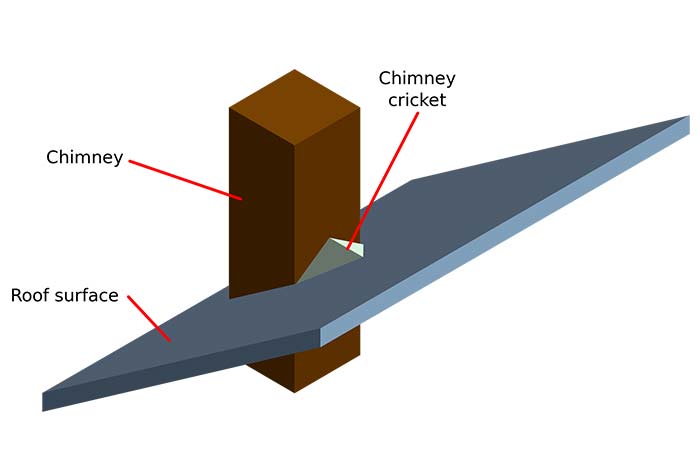
For the shade, simply remove tree branches that grow near/above your roof and any other object that may be creating the shade to allow direct sunlight which dries and destroys the moss.
Low-pressure Washing
When used correctly especially, at low pressure, pressure washers can do a great job when dealing with moss. While this method is gentle, effective and gives quick results, it can be costly and in most cases, it is best handled by pressure-washing pros.
Choose a medium-pressure nozzle for the job preferably a 25° nozzle. When cleaning you should lift your nozzle at least 12 inches from the roof and constantly inspect to ensure no damage is being done.
Always make sure to point the nozzle of your pressure washer downward the roof slope to avoid lifting the shingles off with the water pressure.
Avoid high-pressure washing at all costs. The high pressure can wear off your roof prematurely, displace the pieces, or cause other damages. Instead, either use low pressure if you have some pressure-washing experience or simply use a pump sprayer and a scrubber to clear any accumulation of moss on your roof.
Homemade Roof Moss Killer Recipes
You can also use natural killer solutions such as vinegar and baking soda.
Remove Moss from Roof with Vinegar
Vinegar is an affordable and environment-friendly product that is readily available. This is a natural solution that efficiently kills moss and weed within the first two weeks of their cycle. Both apple cider vinegar and white vinegar can be used to kill moss.
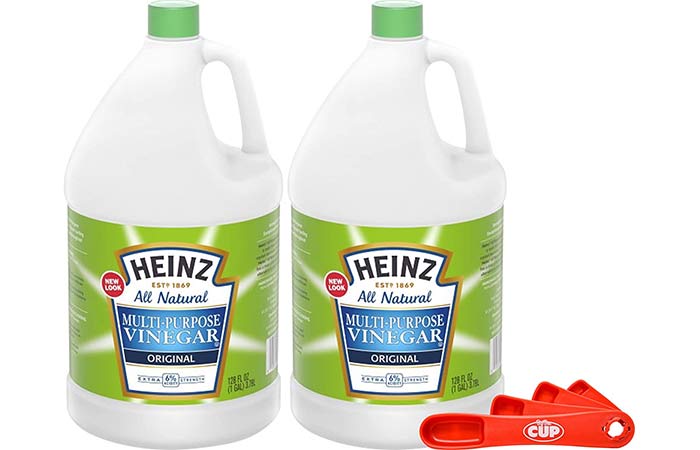
It contains acetic acid that kills moss and other weeds. In addition to its anti-fungal properties which can help prevent moss growth, white vinegar is a natural cleaner, so it can help remove any dirt or debris attached to the moss.
The concentration of acetic acid in commercial vinegar is higher about 25% and more effective to kill moss compared to the 5% concentration in homemade vinegar. Use household/DIY vinegar for new and less-severe moss. Industrial-strength vinegar is best for old and stubborn moss. Below are the steps to clean off roof moss with vinegar.
- In your protective gear, use a ladder to get on the roof, inspect and sweep, blow or rake any visible organic matter (e.g leaves and twigs) on the roof.
- Add distilled white vinegar to a sprayer. The amount will depend on the size of the affected area. If it is a small area use a spray bottle. Alternatively, for new moss, mix full-strength vinegar and water in a ratio of 1:2 and pour it into the sprayer. If the moss is severe, you can apply full-strength vinegar without diluting.
- Using the sprayer, apply the vinegar
- Let the solution sit for some time (24 hours to a few days depending on the condition and severity of the moss)
- Use a brush or scraper to remove the dead moss
- Rinse off the roof with a garden hose/sprayer.
Baking Soda Moss killer for Roof
Besides vinegar, baking soda is an all-natural alternative you can use to get rid of the moss on your roof. The baking soda basically increases the pH hence destroying the moss.
To clean moss on your roof with baking soda, follow the steps below
- Mix a half cup of baking soda and one liter of water.
- Spray the roof with the mixture on a sunny day
- Wait a few days for the moss to die and dry off.
- Brush the moss off with a stiff brush.
- Rinse off the roof.
Chlorine Bleach and Water
Using bleach is one of the most common DIY ways to clean moss off roof. This method works better if the moss growth is new and has not spread over large areas of your roof. You can use liquid, powdered or oxygen chlorine bleach. Below are the steps to use liquid chlorine bleach and water.
- 50:50 mix of laundry-strength liquid chlorine bleach and water.
- Apply with a sprayer
- Let the solution stay on the roof surface for 15 to 20 minutes, Extended dwell times may be necessary, however, avoid letting the solution dry completely as this may prevent complete rinsing and may lead to staining.
- Scrub/Brush of the dead moss
- Rinse thoroughly with low-pressure water.
Oxygen Bleach + Water
Oxygen bleach is less toxic than chlorine bleach and will not harm or discolor your clothing. It will, however, aid in the removal of the moss and any accompanying stains.
- Mix 1 pound powdered oxygen bleach with 2 gallons of water in a plastic bucket.
- Before application, make sure to thoroughly wet the roof first.
- Use a spray bottle or pump to generously spray the solution all over the moss-infested roof.
- let it sit for 20 to 45 minutes then scrub lightly with a soft-bristle brush, and rinse with water before it dries up.
If left till it dries on your roof, bleach will get underneath your shingles and leave behind a tough, dirty residue.
Take proper precautions to protect yourself, the landscaping and the surrounding plantations from bleach. In high concentrations, bleach can discolor your clothes and irritate your eyes, skin and airway. Runoff from bleach on your roof can kill your lawn. Being caustic by nature, it can corrode your home’s downspouts. Repeated and improper use of bleach can also destroy the protective layers of your roofing materials especially, some types of shingles
How to Remove Moss from Roof with Detergents
You can also use some detergents including tide, soap dish among others to efficiently get rid of roof moss. These household cleaners contain sulfate, bleach, and other properties that destroy moss. However, you must be cautious when using detergents. Be sure to check the instructions before use and remember to find out if the detergent is safe for your roof type.
Powdered Tide Detergent
Tide is one of the most popular and readily available products that you can use to get rid of moss on the roof. Here are the steps to remove moss from your roof with Tide Detergent.
Steps
- Put on your safety gear then use a ladder to access your rooftop.
- Directly sprinkle the powdered detergent on the moss-infested parts of the roof. Ensure the sprinkle is enough to cover the moss with a thin yet even layer.
- Using the spray bottle, spray water on the sprinkled tide to moisten it. Ensure the water dampens but does not wash away the detergent.
- Leave it until you notice the moss starting to discolor.
- Brush or scrape the moss
- Using a garden hose rinse off the loose moss and tide. a
- Repeat the process whenever you see moss on your roof
You can as well mix tide detergent with bleach for better results
Avoid using this method when it is raining or windy. The rainwater will wash the detergent away. A strong wind will blow away the powdered detergent.
Dish Soap
Another detergent formula that can help eliminate mild roof moss infestation is dish soap. It
contains alkaline elements that can be effective against moss growth.
Here is how to use dish soap to remove roof moss.
- Mix in a garden hand sprayer 2 ounces of dish soap such as Dawn Ultra liquid dish and 1 gallon of water. Double the numbers if have a large area covered with moss
- Spray the mixture on the moss.
- Let the solution sit for at least 24 after which
- the moss will turn orange or brown and eventually dry up. Dig up the dead moss.
- Scrub it with brush or trowel
- Use a garden hose to rinse your roof.
While detergents are cheap and easy to use, they have some downsides. Detergents come with some degreasing abilities that ruin some types of roofs especially, asphalt shingles. The degreasing effect loosens the asphalt, tar, and oil that are meant to protect the shingles from the outside elements including wind, sun, water, etc.
Detergents are not safe and may cause fatal accidents. They are very slippery and can make you slip and fall from the roof.
Some detergents are made up of chemicals that are dangerous to the environment.
Roof Moss Removers: Top Products
some products on the market are formulated to remove moss from the roof. If you have to use these products, select the eco-friendly options which contain gentle ingredients such as zinc salts and baking soda.
Lilly Miller Moss Out for Roofs
Lilly Miller is a company known for its line of highly effective natural, biodegradable and sustainable products that are eco-friendly as well as economical to use.
Lilly Miller’s Mossout lives up to the brand name as it will kill all traces of algae, lichens or moss on your roof without harming shingles or other materials on top of them. One single application does the trick.
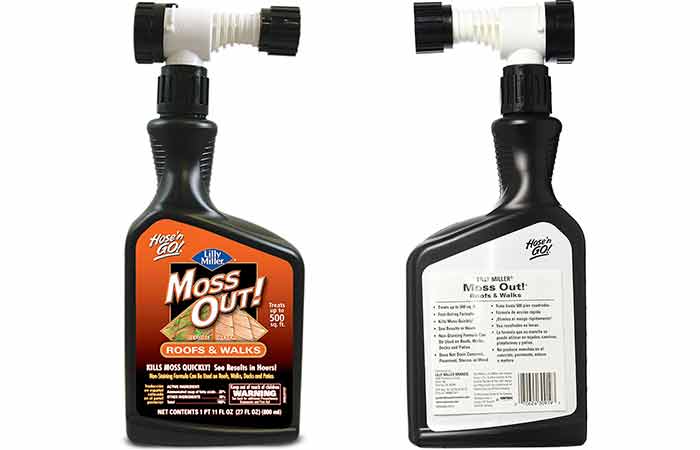
The Lilly Miller product contains this exclusive formula: sodium bicarbonate (a safe pH neutralizer), water softener crystals, dishwashing liquid soap, surfactant blend containing LAS compounds which break down cell walls and clays with non-acid organic acids, sodium percarbonate (a powerful oxidizer that breaks down cell walls at the molecular level), and a mixture of organic acids.
This moss removal product is biodegradable, so it won’t damage your plants or make them sick if you use this to kill moss around their roots. It also leaves no oily residue on top of your shingles like other products might do.
This product has also been certified by Green America’s Eco-Logo Program as being made with not only sustainable ingredients but also recycled materials in its packaging. Lilly Miller brands are “green” from start to finish. Best of all, it works for all roof types.
Wet & Forget Moss Remover
This is a bleach-free, no phosphate and non-acidic roof moss remover. It kills the moss and causes its root-like structures to lift free from your roof, allowing the rain to wash the moss away. As its name reads, all you need for this outdoor moss cleaner is to apply and leave it to do the work…no rinsing or scrubbing!
Besides moss stains, Wet & Forget also cleans stains caused by mold, mildew and algae not only on roofs but also siding, driveway, patio, deck, vinyl, wood, concrete, canvas, aluminum, and upholstery.
If you want remove the moss from the ground without having to use a ladder, Wet and forget has the Xtreme Reach version is designed to attach to garden hose; jet tip that can spray up to 30ft
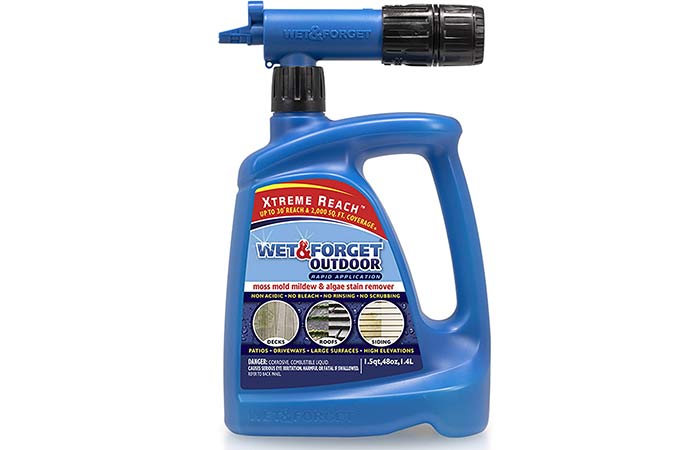
How to clean off roof moss with wet and forget
- Mix 1 part Wet & Forget with 5 parts water in a garden sprayer
- Spray the dry roof on a cool day to avoid rapid evaporation of the solution. Spray when rain is not forecasted within 4-5 hours and the temperature is at least 32° F. Be sure to saturate the moss thoroughly to allow the solution to reach the moss’s root-like structures.
- Do not rinse; wait for moss to soak in the solution
- Cleans over time with the wind and rain, green stains clean up within 1-2 weeks, black stains or heavy, stubborn stains can take several months
- Re-apply once a year, or at the first sign of re-growth.
For severe roof moss cases, you might want to try gentle brushing to lift the dead moss free.
Unused solution of this product can be stored mixed and ready in a sprayer for future applications with unlimited shelf life.
Scotts MossEx 3-in-1 Ready-Spray
Scotts MossEx spray comes in a fast-acting formula that destroys roof moss within hours. All you need to do is apply, scrub and rinse to lift dirt and wipe out stains from moss, mold, mildew, and algae on all roof types. It comes with no chlorine bleach or phosphates, hence safe to use around plants and grass.
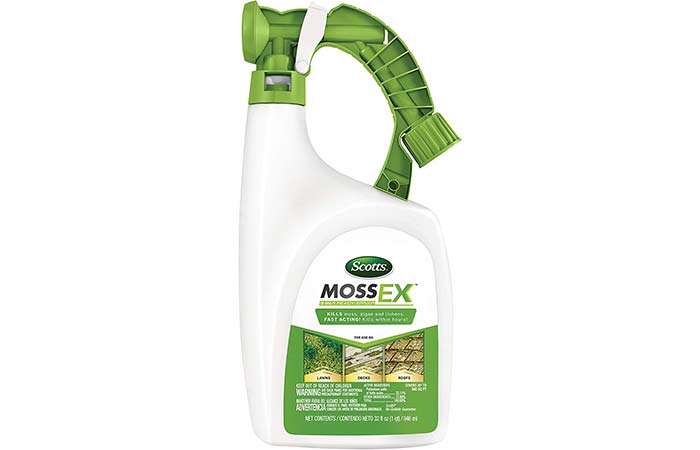
This product contains several natural ingredients which are environmentally friendly and not harmful if inhaled or ingested by humans or animals: Sodium bicarbonate (a naturally occurring mineral), hydrated lime (an important ingredient in baking soda), borax powder (a cleaner that has many household uses), and potassium sulfate.
Scotts spray is ready to use. Just attach it to an outdoor garden hose, turn on the water and it’s ready for use. Apply anytime moss is present and actively growing during the year. Best results are obtained with actively growing moss in spring or fall.
You can eliminate that pesky moss in as little as one day with Scotts MossEx.
BioAdvanced 2-in-1 Moss and Algae Killer
BioAdvanced’s 2-in-1 Moss and Algae Killer and Cleaner uses one formula to kill moss and algae wherever it grows. It is a non-bleach and odorless formula that also kills lichen, mold, and mildew. It will also not stain or harm lawns.
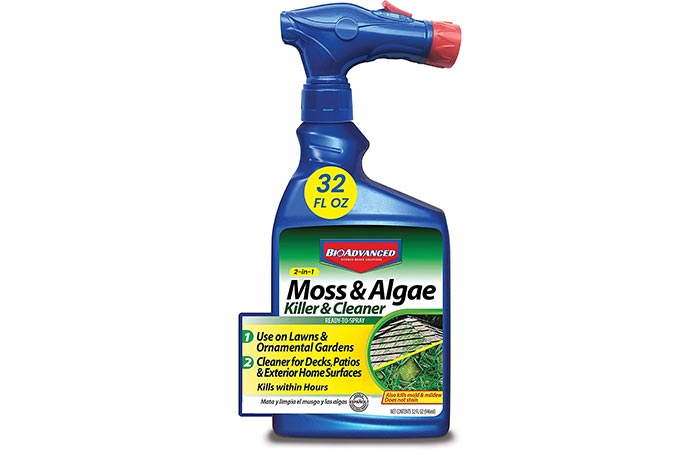
The active ingredients in this product are potassium salt of fatty acids, which are generally regarded as safe by the Food and Drug Association (FDA). It rates at 70% for effectiveness on the water meter scale (CPC) as well as being non-corrosive to plastic pipes and metals such as aluminum siding or gutters.
It works to destroy within hours. The moss will quickly turn yellow, then brown and can be washed away by hand or by rain. With just one application, it protects for up to one year and can also be used on lawns, patios, roofs, buildings, decks, driveways, and more.
The ready-to-spray applicator is easy to use. Simply attach the product to your garden hose, turn on the water, and use your thumb to activate the sprayer. 32 ounces of this product treats up to 500 square feet.
Apply anytime moss, algae or lichen are growing
Simple Green OxySolve Total Outdoor Cleaner
This is yet another outdoor cleaner that you can you use to remove moss on roof surfaces especially those made from metal, asphalt and concrete.
Besides removing moss, you can also use this cleaner to clean off dirt, grime, and stains from mold, mildew, and algae
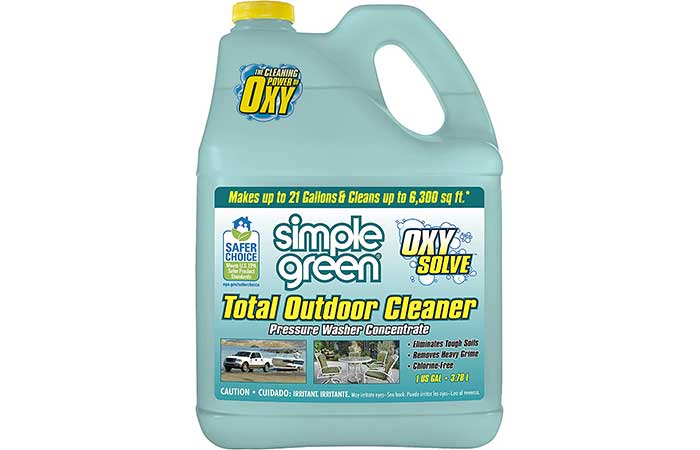
While it is a pressure washer concentrate, you can safely use it without a pressure washer. Following are the steps of how to use it.
- Mix 1-measure of Simple Green Oxy Solve with 20-measures of water in a bucket (example: 1.5 cups Simple Green to 2 gallons water).
- Using a bottle/pump sprayer to apply the solution on roof parts that are affected with moss
- Let the solution sit for 3-5 minutes (do not let the solution to dry)
- Clean in sections with a brush or sponge.
- Rinse with a garden hose.
30 Seconds Outdoor Cleaner
30 SECONDS Cleaner quickly cleans stains from not only moss but also other organic growth including algae, mold, and mildew. All you need is to spray on and hose off. When use properly, it is safe around your lawn and plants.
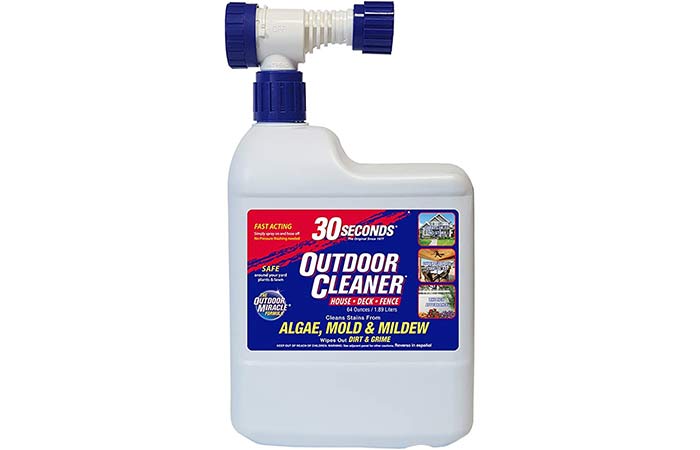
Works on a variety of surfaces: wood decks, concrete sidewalks, asphalt driveways, brick walls, most canvas awnings, plastic outdoor furniture, vinyl siding & more. Breaks down once rinsed into the soil
Best Time of the Year to Remove Moss from Roof
Understanding the right weather conditions and time or season of the year to do away with moss on your roof is key if you want the best results with minimum expense, time and effort
The best time of the year to remove moss from the roof is summer prior to the peak of fall rains. This is because during summer months the sunny and drier conditions do not favor moss growth. At this time, the moss is almost dormant or slowly but actively growing and it is also brittle, which makes it highly vulnerable to most moss chemical killers and other manual removal methods. As moss dies, the rains ahead will help wash the dead moss away
When using chemicals, it is best to do so on a cloudy day or early in the morning. These roof-cleaning products will not evaporate as quickly as they would on a sunny day because they must be allowed to absorb into the moss for at least 20 minutes.
When using manual removal tools and powdered products avoid windy conditions. Wind can blow away the powdered remove and spread moss spores.
In fall, winter and spring, the moss absorbs as much water as it can it grows fast and reproduces, meaning that it will take several treatments to remove the moss completely. Heavy rains can dilute and wash away the treatments. It is also quite risky and difficult to carry out roof cleaning in wet, windy or icy conditions.
While summer is the perfect timing in most cases, it is even more important to do away with moss whenever you notice any growth on roof especially, in the early stages before it spreads and gets out of control. You do not have to wait for summer.
How to Prevent Moss on Roof & Stop Growth
Roof moss prevention measures aim to change the conditions that are responsible for its growth. The above moss treatment and removal methods only cure the symptoms.
To prevent moss on your roof, conduct frequent inspections to understand the condition of the roof, conduct regular roof and gutter cleaning, install metal strips, consider moss-resistant roofs, remove sources of shade, etc. Following are the details.
1. Frequent Inspections
Inspecting your roof and gutter system is critical in understanding its condition and it helps with planning the right maintenance routine, which will, in return, increase its life
Regular inspections can help detect the moss growth signs on time and stop further spreading. During the inspections pay attention to moss-prone sections of your roof. Also, remember the rain gutters and downspouts.
2. Regular Roof & Gutter Cleaning
You should clean your roofs periodically to remove any accumulated organic dirt and debris. This will help prevent moss growth because moss depends on such for its growth.
Accumulated dirt debris can also hold water thus adding another growth factor for moss and thus should be removed regularly as needed.
Clean/unclog your gutters often to avoid stagnant water staying for long periods on your roof’s surface.
Further Reading: Best Gutter Cleaning Tools
Ensure your downspouts are free of any obstruction. If you have some type of obstruction, preventing rainwater runoff from flowing to the ground, do remove it.
Make sure that there is always at least one straight line running off your rooftop where water can flow freely with no impediment throughout.
3. Installing Metal Strips
Install a copper, zinc, aluminum or galvanized metal strip on the roof’s ridge to prevent the growth of moss, algae, and lichen. When it rains, the strip oxidizes and washes down the roof plane, making the roof plane uninhabitable for moss, algae, and lichen.
It is important to note, however, that adding the metal strip will take some time to start inhibiting moss. You shouldn’t expect it to deal with an existing moss infestation on its own, only to prevent a new one.
4. Apply Baking Soda or Lime Periodically
As explained before, baking soda and hydrated lime are bases and help inhibit and prevent moss growth by changing the pH.
After every cleaning, you can sprinkle either all over your roof surface to prevent moss growth, and reapply when necessary whenever the previous one has been washed off.
5. Removing Sources of Shade
Moss grows best in the shade, so exposing more of your roof to sunlight will help keep it at bay. Consider trimming trees that cast shade on the roof or relocating garden features such as pergolas or trellises so that they do not cast shade on the roof.
Furthermore, trimming overhanging tree branches that drip rainwater or deposit wet leaves on your roof, will help reduce the amount of organic debris while also allowing your roof to receive more direct sunlight.
If you have just built a new house consider not planting trees around your house. If you have to plant vegetation near your house, consider plants that do not need a lot of watering such as drought-resistant succulents. This is because they do not need to be watered very often and their branches aren’t very watery so cannot cause damage when stuck beneath your roof tiles.
6. Consider Moss Resistant Roofs
If you are installing a new roof or re-roofing, consider a metal roof or algae-resistant shingles.
Moss and other organic growths are rarely an issue with metal roofs considering that their lifetime cost is comparable to composite roofs.
Algae-resistant shingles when re-roofing are chemically treated roof shingles available from many asphalt roofing manufacturers. These shingle types have chemicals that hold out against moss, lichens, or algae growth on roofs.
However, remember that moss-resistant roofs would still require that you do away with any excessive shade and organic debris on your and gutters.
More prevention measures and tips.
- If you have a flat roof: use two drip lines to keep water off of the surface so that moss cannot grow.
- Consider using an ice shield or clearing snow in the wintertime.
- Be sure not to over-fertilize plants around your house since fertilizer contains phosphorous which contributes towards the growth of moss.
- Consider using a sealant that contains no phosphates when re-roofing your home.
- Do not paint your roof or near the exterior walls without clearing any vegetation first. Water can get trapped under wet painted surfaces which provide an ideal environment for moss growth, or it may drip onto the surface providing moisture close enough for moss spores to take hold.
Roof Moss Removal Cost?
Roof moss removal and prevention costs can range between $100 and $700 or more. This price range can vary depending on many factors including;
- Roof Size-General roof cleaning costs between $0.20 to $0.60 per square foot. Prices increase for larger roofs or complex roofing systems that require more detailed work.
- Roofing material/Roof Type-Cleaning delicate roof materials may require special tools, increasing costs.
- Roof Shape and Slope-Steeper roofs require more safety precautions and equipment, hence pricier.
- Roof moss condition- How often you remove the moss from your roof affects the price. You will pay more if the moss on has lasted for ages.
- Extra services such as gutter cleaning, metal strip installation, adding a coating, etc.
- Cleaning method, be it a DIY or professional
- Number of stories
- Where you live(location)
- The cleaning time
How Bad is Moss on Roof?
The moss on your roof may appear attractive and innocuous, but it can actually pose a serious threat.
While the mere growth of moss may not damage your roof’s surface, the rhizoids trap soil and debris, which retain water and keep the roof wet for a longer period of time. Established moss maintains a steady moisture level on your roof by absorbing moisture from above and below like a sponge.
If left untreated the moisture and accumulated debris promote the formation of rot, bacteria, and mold(fungi) which damage your roof affecting the integrity of your entire roofing system.
Moss spreads beneath your shingles and slates, uprooting them and causing significant damage. This uprooting can cause holes, leaks, and structural damage to your roof.
The damage extends from shingles to rotten underlayments and structural damage. Worse, once the moss has been removed from your roof, the shingles may fall back oddly due to the loss of the moss structure that once supported them.
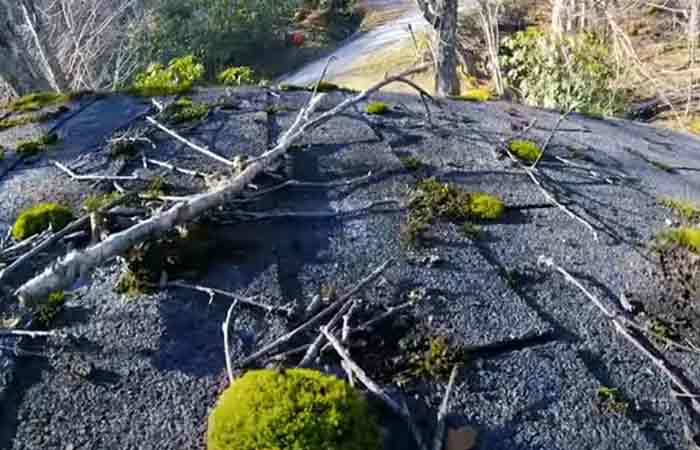
Moss can also cause the leading edges of the shingles to curl, which increases the risk of shingle blow-off during wind events. In severe cases, moss build-up can cause lateral water movement resulting in moisture damage to the roof deck or may even result in leaks.
Moss growing in between roof tiles can fill up the voids between them which can lift the tiles and expose what lies underneath to the elements resulting in rotting timber or damp insulation.
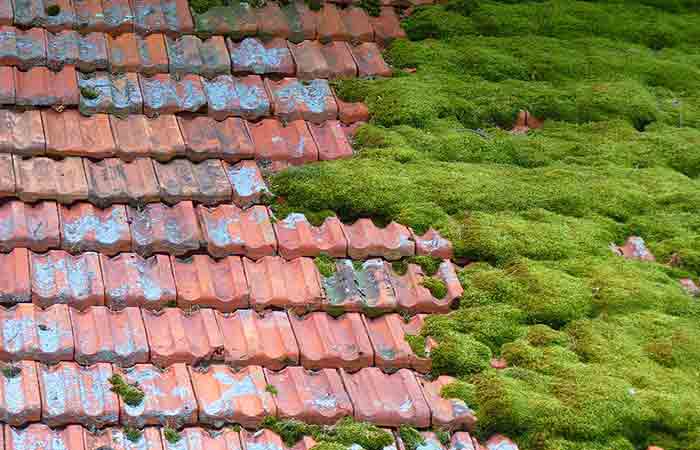
Because of its ability to retain water, moss can also cause rusting and corrosion on metallic parts of the roof or gutter made of iron or steel.
Moss on your roof can also be a factor for insurers to decide how much you’ll pay for your homeowner’s insurance policy. A severe moss infestation can significantly decrease your roof’s lifespan leading to roof replacement and other costly repairs that insurers will either want to avoid at all costs or charge more.
Nevertheless, even after you insure your home, it is still subject to random visual inspection by your insurance company – and it is within their right to cancel your insurance policy or increase your premiums unless you have the moss removed
Other problems that are linked to roof moss include;
- Robs your house of heat during the winter months
- It’s slippery, so it increases the danger and difficulty of working on your roof.
- Moss spores may also be carried by wind or animals and can easily spread throughout neighborhoods.
- Attracts more organic growth
- It is unsightly
What Roof Moss Removal Methods Should I Avoid?
Some methods to avoid in the following
Pressure washing
Pressure washers have the potential to be incredibly powerful, more than capable of dislodging and lifting shingles. Additionally, they have the ability to remove the granule surface from asphalt shingles, which will degrade both their appearance and performance. Any amount of pressure washing might seriously damage the roof and result in significant leaks. Never spray your roof with a powerful jet of water with a pressure washer.
Using harsh chemicals
Bleach and other chemicals in high doses can permanently harm shingles, increasing the likelihood of leaks. You should also avoid strongly acidic cleaners because they wear out roofing materials.
Additionally, when these chemicals seep into the environment, they can harm plants and other organisms, posing a risk to the environment.
Aggressive Scrubbing
Because moss adheres to shingles so strongly, you may be tempted to scrub it off vigorously. Scrubbing too hard, on the other hand, is likely to damage the asphalt shingles and remove their granules.
Why is Moss Growing on My Roof-Causes
Moss is a type of non-vascular herbaceous plant that grows rapidly on many surfaces. It starts its life as spores that are carried by the wind, or even birds, and can land on your roof and other surfaces.
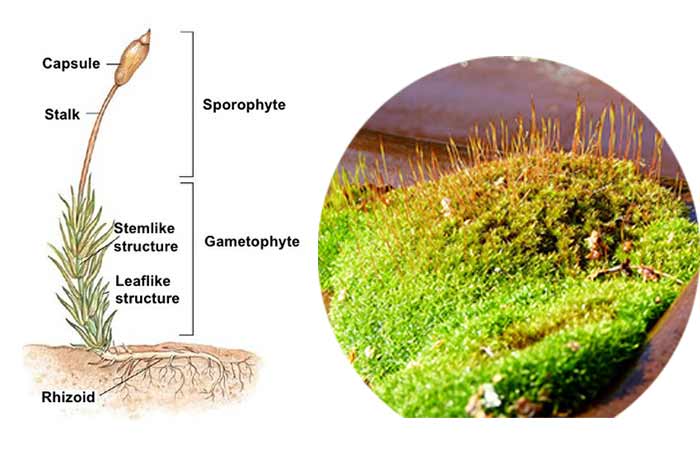
Moss attaches itself to any organic material that is available, and uses this as its anchor, or base, for growing. Moss growth is far more likely on damp, cool surfaces that don’t receive much sunlight
Below are some of the things on your roof that could be causing the growth of moss:
Moisture – Moss requires a relatively damp environment to grow, but it will not thrive in a swampy environment. The gaps beneath and between shingles are frequently damp and provide the moisture moss required to grow.
Dirt and organic debris – Debris from fallen leaves on the roof and dirt act as an ideal food source for moss, providing anchorage and even holding the moisture required for growth.
Shade – Moss prefers to grow in the shade, which makes sense because moisture tends to linger in these areas, making the moss less likely to dry out quickly.
What if the Moss Appears Dried & Dead?
When the weather is consistently dry, the moss becomes dry and brittle, giving the appearance of being dead.
Dried moss is dormant and loses its green hue with time. When rehydrated, however, it will come back to life and begin growing again.
Most moss species can survive for months after being dried out. It only needs one rain to recover and continue growing. If your moss has dried out, take advantage of the opportunity to have it removed as it is easier then.
What if the Moss Grows Back?
If the moss grows back after previous attempts of removing it, you remove it before it is established further. Most importantly, you should carry out preventive measures to prevent it from growing.
You can do this by sprinkling baking powder, applying vinegar or other substances that kill moss and prevent regrowth. Installing zinc and copper plates as mentioned before is also a good preventive measure after cleaning the moss.
Does Moss on Roof Mean the Roof Needs to be Replaced?
Moss on the roof does not always mean you need a roof replacement. However, you may have to replace your if the moss has caused severe damages that are beyond repair. It all depends on the extent of the damage.
Moss at an early stage does not damage the roof and can only cause slight and superficial damage. This is thus not a big concern since you can fix it by simply removing and preventing the moss. This is actually cheaper and easier than replacing your roof
However, when the moss infestation has stayed for long and done extensive damage to the roof and roofing materials, all should be replaced. This might also come up with other costly repairs and that is why you should deal with moss at an early stage before it gets out of control
Safety Precautions
While there are situations you might require a professional roof cleaner to handle the moss on your roof, in most cases, it is a chore that you can handle on your own if you have the right tools and access to the roof. Here are a few precautions to stay safe.
- Always follow product label instructions closely, and make sure the label lists your roof and gutter materials before you treat.
- Cover any plants right below your roof line during applications. If the cleaning solutions drip down, rinse plants well to ensure no damage
- Because some cleaning methods and the moss are slippery, consider putting on footwear that provides good traction and will grip the roof surface.
- Always protect your eyes, hands, skin, etc. with the right safety gear, especially when working with harsh chemicals
- Where possible, walk across the roof in lieu of up and down to reduce the chance of slipping.
- When applying removal solutions, work backward on your roof. This keeps you safe by not allowing you to step onto a wet, slippery tile. It is also efficient to work this way.
- Whenever you are using a ladder, ensure that it meets all safety requirements, is properly set on stable ground, and secured to the roof at the top
- To stay safe and stable on the ladder, use a bucket and rope to move tools and other items to the roof.
- If possible, walk across the roof rather than up and down to reduce the chance of slipping.
- Use safety lines, belts, and helmets, especially if the roof pitch is 5 to 12 or greater (more than 23°), the eves are more than 16 feet from the ground or when you’re working closer than 6 feet to the roof edge.
References
- http://bryophytes.science.oregonstate.edu/
- https://dochub.clackamas.us/documents/drupal/ad9e796c-87d8-484e-ad9c-f464e5fef7f9
- Dietert, M. (1979). Studies on the Gametophyte Nutrition of the Cosmopolitan Species Funaria hygrometrica and Weissia controversa. The Bryologist, 82(3), 417-431. doi:10.2307/3242217
- Armentano, T., & Caponetti, J. (1972). The Effect of pH on the Growth of Protonemata of Tetraplodon mnioides and Funaria hygrometrica. The Bryologist, 75(2), 147-153. doi:10.2307/3241442
As an Amazon Associate, we earn from qualifying purchases. Details here
